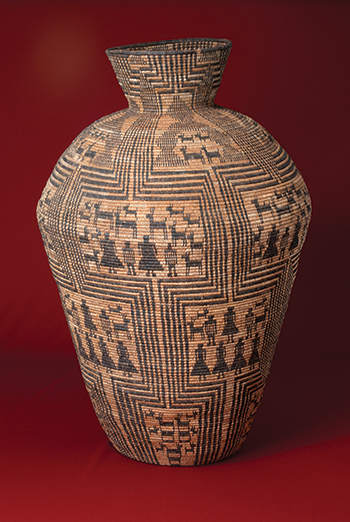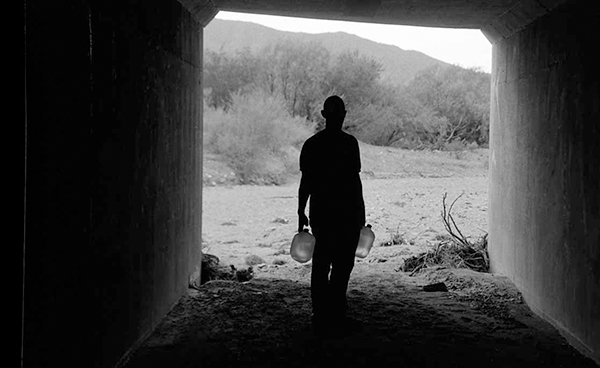Borders & Baskets
Stirring the Imagination Via Photos and Fiber
In two contrasting exhibitions, the iconography of intimate photos and the designs of traditional weaving invite audiences to reconsider their understanding of our region’s culture…and soul.
Step into the Main Hall of the Arizona State Museum (ASM) and soon you will have a quandary. To one side is a current exhibition that plunges into the power of traditional basketry as a source of inspiration, function and beauty. To the other, beginning March 8, is a new conversation in the form of intricate photography, in an exhibition that makes you look again at the immigration discussion. Where to turn first?
The creative excitement stirred in these striking ASM exhibits comes from a sense of place that is undeniably Sonora, a celebration of a region reborn in images and baskets. You need all your senses and imagination to undercover the stories behind these two unique exhibits that demonstrate the intersection of culture, conscience and community in amazing ways.
Provocateur in Focus
A World Separated By Borders
Photography of Alejandra Platt-Torres
ASM Exhibition March 8 – October 19, 2013
Written in the language of the camera, an exhibition opening next month already is stirring a deeper collective thought about migration.
Alejandra Platt-Torres’ photographs are full of dramatic social commentary, and paint magical realism with melancholy and optimism. There is no flamboyancy in her images, just the vivid honesty of larger-format film photography that fractures the notion of pixel-perfect beauty.
The upcoming ASM exhibition will be multi-layered, featuring as its central focus 20 of Platt-Torres’ most stunning black-and-white photographs. The photos depict migrants, their desert journeys, human repatriation, border history and ecology.
In another layer, the exhibit experience will begin almost as a pilgrimage via a “desert walk” – Images of desert floor footprints and fragments become a walkway leading exhibit-goers into the Museum and the core of the “journey,” the photographic exhibition. There, a concluding layer will feature a conceptual “Sanctuary” installation –a slide show of additional Platt-Torres photos projected on to a desert shrine image – accompanied by a soundtrack by Salvador Duran.
According to ASM Curator of Exhibits Davison Packard Koenig, the exhibit offers visitors an opportunity to comment and reflect.”The exhibit is not necessarily to present all aspects of the border dilemma, but rather to humanize the border through the lens of Alejandra’s compelling imagery,” he notes.
The project represents over four years of Platt-Torres documentation of the border, which began after September 11, 2001. At the time, the photographer had been at the border crossing, and she recalls vividly the changes that began occurring after that terrorism event.
“I am the third generation in a family of migrants and my great grandfather was born in New York City,” says Platt-Torres. “Since I was a child, I’ve been crossing the border with my family – there is no border in my world.”
But post-September 11 reaction prompted Platt-Torres to photograph images that symbolized the tension fueled by border issues as well as human casualties. “The photos began to reveal their meaning to me,” she says.
Platt-Torres’ most compelling works convey a sense of personal connection, almost engaging the viewers in conversation. She employs a Hasselblad 500 film camera, bringing viewers closer to the monumental subject matter by way of large-scale images.
The University of Arizona Confluencenter for Creative Inquiry is a partner in the exhibit. “Alejandra Platt-Torres is one of the most accomplished photographers of contemporary Mexico, says Dr. Javier Duran, director of the UA Confluencenter. “Her photos evoke the strength, the struggles and the sorrows of the migrant people and reflect the lives of those who made it across and those who didn’t.”
Torres-Platt was born in Hermosillo, Sonora and now divides her time between Mexico and Tucson. She began photography when she was seven, using an Instamatic as her tool. Her photos reveal the truth of often uncomfortable subject matter in ways that can surprise the spectator. Like the desert itself, the photographs of A World Separated by Borders are both fragile and timeless.

Arizona State Museum’s largest example is a stunning Yavapai or Western Apache coiled olla that is almost 3.5 feet tall. It probably was made just after 1900 by an anonymous but extremely talented weaver who may have lived at San Carlos. Photo by Jannelle Weakly, from the permanent collections of Arizona State Museum.
Vessels of Tradition
Basketry Treasured
ASM Exhibition through January 4, 2014
You come here for the gravitas. If you haven’t visited the exhibition’s sampling of the world’s largest collection of American Indian basketry, you should. Some 500 rare pieces, representing every indigenous basket-making group in North America from 6,000 years ago to the present, take viewers on a visual journey into culture. It’s a display of objects at first familiar but upon inspection transform into artful experiences of tradition and technique.
Basketry Treasured was unveiled last year as part of ASM’s Arizona Centennial programming and is a sweeping spectacle of baskets and what the Museum calls “other woven wonders” (including sandals, mats and cradles made from native botanicals). The exhibit gives viewers a window into the past and future of a traditional art used for ceremony and function. Through displays that are almost architectural, the exhibit provides a modern commentary on beautifully structured and designed cultural objects. Diverse ground is covered and no matter what your style, the baskets resonate. Visitors explore the nature of tradition in an inviting touch-and-feel area, or get connected via an introductory film full of native voices. In a display of miniature baskets, viewers are enriched by small-scale artistic structures that pay homage to ancestral traditions. Personal collections of three major Museum influencers dating to early 20th century are displayed around an entertaining “Indian Room,” where absorbing contextual posters embellish storytelling.
The future of basketry is also elegantly realized in the exhibit’s collection of contemporary pieces. This display demonstrates how today’s artists successfully adapt knowledge of elders to reflect images that capture a modern essence with intense design. Terrol Dew Johnson, a contemporary Tohono O’odham weaver, is collaborating curator of the exhibit. His community organization, TOCA, based in Sells, creates opportunities for learning, exchange and livelihood, and has helped his Tohono O’odham nation retain balance in honoring the past while entering mainstream. Dew Johnson’s work is showcased along with other contemporary artists in the show, building upon traditional patterns with originality that extends the expressive range of the craft.
Basketry Treasured is also presented in honor of a $400,000 Save America’s Treasures challenge grant, which intends to kick-start the construction of a climate-controlled “visible vault” and interpretive space for the woven wonders. ASM hopes the exhibition inspires viewers to support a new, upgraded venue for the collection, which continues to face risks of deterioration. As you walk the exhibit and reflect about what baskets old and new teach about the cultures of the people who made them, perhaps you’ll wonder what other baskets are hidden in the museum and what stories they might tell you.





